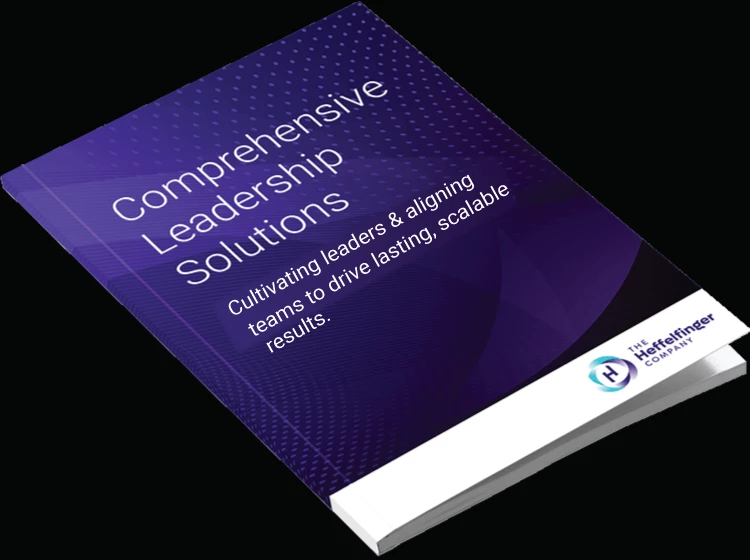"The better able team members are to engage, speak, listen, hear, interpret, and respond constructively, the more likely their teams are to leverage conflict rather than be leveled by it." ~ Runde and Flanagan
We are back at this topic of conflict. When we looked at our Blog analytics we noticed it had one of our highest open rates and we received a lot of positive comments from you, our readers, so we are back at it with some more information for you.
Nearly 43% of CEOs rated "conflict management skills" as the biggest area for their personal development (Stanford University). One of the top talents sought from CEOs to CHROs is coaching for conflict management to leadership teams.
Stakeholder overload is a real burden for today's Leader, who must deftly learn how to negotiate often conflicting agendas. Even experienced leaders avoid conflict. And managing conflict is part of everyone’s role in the organization (and frankly we would advocate you make this a life skill to use both inside/outside of work).
Learning how to manage emotionally challenging situations by being more open-minded can be one of the best things you can do to grow your leadership, teams, and organization, and, frankly, your own personal satisfaction.
We like and use the Ladder of Inference, created by Chris Argyris, an organizational learning leader and former Harvard Business School professor. The model is about our thinking and reasoning process. The key is to be aware of where you are on the ladder in your thinking process. Staying low or off the ladder keeps us closer to what is real versus what we perceive or assume is real. This tool is useful for conflict resolution and helping teams come to conclusions and perform actions based on sound judgments and facts.
The Ladder of Inference lays out the steps in our reasoning—from observing data to drawing conclusions, adopting beliefs, and taking actions. It also helps explain what data we will select to observe in the future.
The Ladder of Inference can help us examine how we came to make decisions and take particular actions. It can also help us remain objective when working or challenging others to reach shared conclusions minimizing unproductive conflict. (It's also a model for how we form cognitive biases (more on that in a future blog).
Here is how the Ladder of Inference reveals our reasoning process:
(Image source: origin unknown; concept by Chris Argyris)
- We begin at the bottom with the pool of information available to us—the observable data and experiences.
- We then select some of the information ("data")—typically that which grabs our attention or seems particularly significant—and ignore the rest.
- We then interpret the information, drawing on personal and cultural meanings, and make assumptions about the selected data based on those meanings.
- We draw conclusions based on those assumptions. Over time, these conclusions inform our beliefs.
- Finally, we make decisions and take actions based on the assumptions filtered through our beliefs.
- Those decisions and actions then add to the pool of data and experience and we start again, this time with new beliefs added to our filters. (Harvard Business School)
Our brain is designed to jump up "the ladder" quickly as part of our self-preservation process. With each rung of the ladder, we lose more data – and perspective. Notice how the rungs get smaller as you go up the ladder in the above image. Our brain serves us in this process when we need to act quickly, such as in times of danger, we can make decisions quickly based upon data and experiences. As leaders, it is crucial to be aware of our assumptions and beliefs as our brain processes the information.
When it comes to conflict management, we can use The Ladder of Inference to detect and sort out our automatic thoughts. If you recall from our previous Blog and Zen Friday event on Productive Conflict, we offered a process, using Cognitive Behavioral Therapy (CBT), to convert unproductive, possibly, mean-spirited conflict to productive conflict.
By identifying our automatic thoughts, that we process as fact or truth, and then take actions on, we can examine their source and validity; we can change those thoughts and, ultimately, our actions. Using the Ladder of Inference, we can sort out the beliefs, conclusions, assumptions, and meanings that make up our automatic thoughts.
As an example, Bob is an executive. His company is making many changes to allow the employees to work from home for the long run and possibly permanently. Bob is against the move because he believes that the employee camaraderie and team spirit he has worked to build over the last few years will slowly devolve back to the chaos he found when he took over the department.
In a heated discussion with his boss, Bob catches himself thinking, "she thinks that I am a control freak and cannot do my job." Bob realizes that this is an automatic thought that shows up whenever someone questions his management style.
Realizing that he is about to say something that would severely damage their relationship, Bob takes a moment to see where he is on the Ladder of Inference. He finds that it is a belief that teams are only effective when they work closely with each other and in person. He also sees he has assumptions about the delicate balance of the team's dynamics.
He based his assumptions on his past successes that did not include virtual teams. He responded to his boss that he would find new methods to connect with his team. Bob then looked for data on other successful teams that were virtual.
When we climb up the Ladder of Inference, and we will, we are in danger of making decisions and taking actions based on assumptions, conclusions, and beliefs that may not be fact or data-based —staying as close to the original data as we can we ensure that we keep our automatic thoughts in check and keep our conflict situation productive.
Our role is to develop an awareness of our filters, meanings, and assumptions to develop better conclusions before making decisions and taking actions. And when we move quickly up the ladder – which we will – to know how to swiftly move down the ladder.
Staying Low on the Ladder of Inference
To stay low on the ladder to avoid misunderstanding, you can:
- Listen deeply to what the person is saying, to ensure you have all the data.
- Stay curious about what the other person is saying – data, and about your thought process – assumptions and beliefs.
- Ask open-ended questions to clarify your understanding.
- Can you help me understand your thinking?
- What was your chain of reasoning?
- What assumptions are you making?
- On what data/facts are you basing your recommendation?
- Notice and observe where your thoughts are taking you.
How to walk yourself down the ladder of inference - follow the ladder rungs down by asking:
- Are there other actions to consider?
- What beliefs am I holding? What other equally valid beliefs might be in play here that I might not be aware of?
- Am I jumping to conclusions? What led me to those conclusions? Am I open to other conclusions, if I can understand what led others to those conclusions?
- What assumptions have I made? Can I share my assumptions so that others can understand how I got to where I am? Am I willing to listen to other assumptions so I can learn where they are coming from?
- What meaning am I adding? Am I even aware that I am doing this? How do I catch myself long enough to notice the meaning I am adding? Am I willing to slow down?
- Am I using all of the facts or data available? How can I stay here at the bottom of the ladder and take in a lot more facts and data that I normally do? Am I willing to tap alternative sources of data and parties who hold that data/perspective? THIS IS REALLY THE SECRET SAUCE of this Ladder! Staying HERE for as long as possible and getting others down here as well.
Lead onward!
Lori and James
Supporting business leaders and HR/OD Leaders to transform cultures and transition through the pandemic and beyond.
Lori Heffelfinger, MSOD, PCC & James Jackman, MSOD
Every Gathering features a different theme that can be customized, though shares a common framework:
- Person-to-person connection for emotional health
- Meaningful conversations to process experiences
- Evidence-based mindfulness practices
- Infusion of the arts through music or poetry
Please ask us more about Gatherings for your teams. We genuinely want to support you and your teams during this time. Contact us to schedule 15-minutes to explore solutions for your teams.







